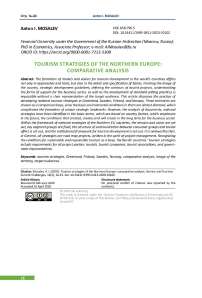Tourism strategies of the Northern Europe: comparative analysis
Автор: Mosalev Anton I.
Журнал: Современные проблемы сервиса и туризма @spst
Рубрика: Локальное в глобальном: формула туризма
Статья в выпуске: 1 т.14, 2020 года.
Бесплатный доступ
The formation of models and visions for tourism development in the world’s countries differs not only in approaches and tools, but also in the detail and specification of States. Forming the image of the country, strategic development guidelines, defining the contours of tourist projects, understanding the forms of support for the business sector, as well as the development of standard-setting practices is impossible without a clear representation of the target audience. This article discusses the practice of developing national tourism strategies in Greenland, Sweden, Finland, and Norway. These territories are chosen as a comparison base, since the basic environmental conditions in them are almost identical, which complicates the formation of unique strategic landmarks. However, the analysis of documents, national strategies have been identified in the basic terms, which are based on country factors, which emphasize in the future, the conditions that created, creates and will create in the long term for the business sector. Within the framework of national strategies of the Northern EU countries, the mission and vision are set out, key segment groups are fixed, the structure of communication between consumer groups and tourist offers is set out, and the institutional framework for tourism development is set out. It is noteworthy that, in General, all strategies are road map projects, written in the spirit of project management. Recognizing the conditions for sustainable and responsible tourism as a base, the Nordic countries ‘ tourism strategies include requirements for all project parties: tourists, tourist companies, tourist associations, and government representatives.
Tourism strategies, greenland, finland, sweden, norway, comparative analysis, image of the territory, target audiences
Короткий адрес: https://sciup.org/140249862
IDR: 140249862 | DOI: 10.24411/1995-0411-2020-10102
Список литературы Tourism strategies of the Northern Europe: comparative analysis
- Ahnlund, C. (2010). Tourism Strategy at Swedish Transport Administration. WIT Transactions on Ecology and the Environment, 139, 13-19. DOI: 10.2495/ST100021
- Augustin, M.M. (2012). Tourism Supply and Demand. Tourism: the key concepts / ed. by P. Robinson. NY, USA, 250-253.
- Bohn, D. J. (2019). Evaluation in Tourism Planning: An Examination of Finland's National, Regional and Local Tourism Strategies. A dissertation completed in partial satisfaction of the requirements of master's degree program in Tourism, Culture and International Management (TourCIM). Rovaniemi: University of Lapland.
- Eimermann, M., Mattsson, K. T., & Carson, D. A. (2019). International tourism entrepreneurs in Swedish peripheries: Compliance and collision with public tourism strategies. Regional Science. Policy & Practice, 11, 479-492. DOI: 10.1111/rsp3.12148
- Jacobsen, J. Kr., Dybedal, P., & Skalpe, O. (1996). Foredlingsstrategier i norsk reiseliv. Evaluering av SNDs stating på videreforedlingsapparatei i reiselivsnæringen. Oslo: Transportøkonomisk institutt.
- Kirsten, T. (2012). Pioneering Nation - markedsføring af Grønland under selvstyret. Tidsskriftet Grønland, 3, 214-225.
- Maiden, J. A. (2008). Participation in Sustainable Tourism Development: Stakeholders & Partnership Working. A dissertation completed in partial satisfaction of the requirements of Doctor of Philosophy. Cardiff: Cardiff University.
- Riege, A., & Perry, C. (2000). National marketing strategies in international travel and tourism. European Journal of Marketing, 34 (11/12), 1290-1305.
- DOI: 10.1108/03090560010348452
- Stępień, A. (2016). Other futures for Arctic economies? Searching for alternatives to resource extraction. Rovaniemi, Finland: ArCticles. Arctic Centre, University of Lapland.
- Uçar, A., Akpinar, R., & Negiz, N. (2018). Ulusal turizm stratejisinin yerele yansıması: GEKA örneği. Journal of Tourism Theory and Research, 4(2), 133-147.
- DOI: 10.24288/jttr.445979
- Vuoristo, K.-V. (2002). Regional and structural patterns of tourism in Finland. Fennia, 180:1-2, 251-259.
- Waligo, V., Clarke, J., & Hawkins, R. (2015). Embedding stakeholders in sustainable tourism strategies. Annals of Tourism Research, 55, 90-93.
- DOI: 10.1016/j.annals.2015.09.002


